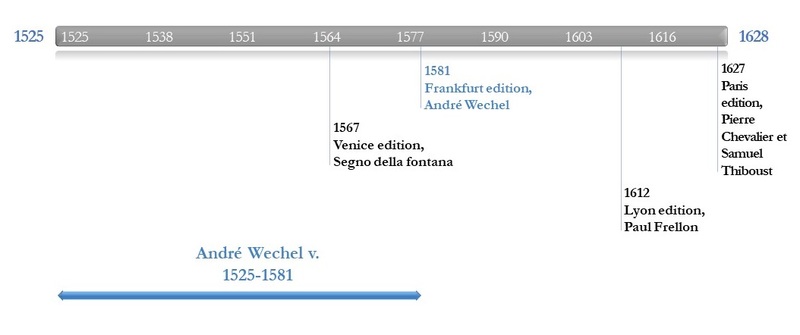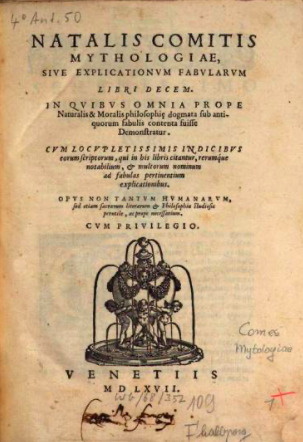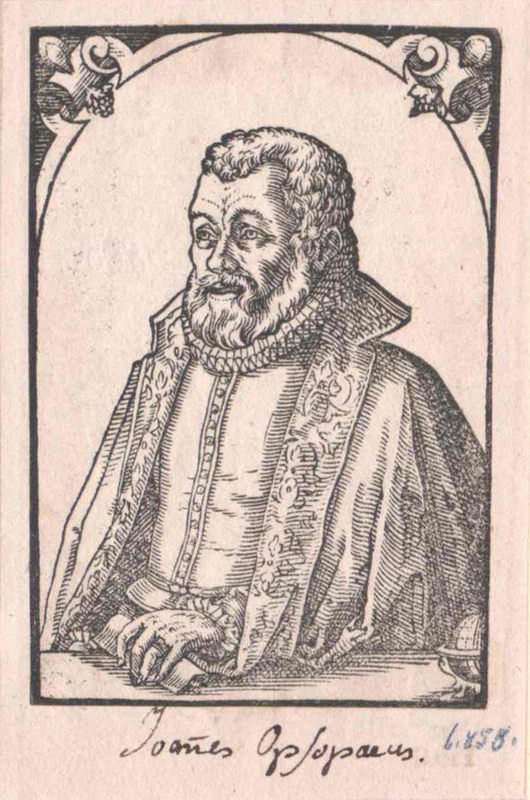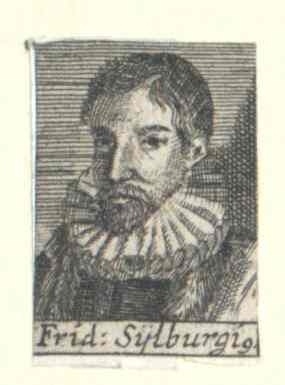
André Wechel printer's mark
title page of Mythologiae libri, 1581
@ MDZ 1999 Hist.pol.1307
André Wechel was born around the year 1525 as the nephew of the famous Parisian printer Chrétien Wechel (1495–1553), a native of Brabant, and died in Frankfurt in the autumn of 1581 as one of the most influential and wealthy publishers of the free imperial city.[1] Together, Chrétien and André were the founders of a widely ramified dynasty of printers that lasted until the first decade of the Thirty Years’ War (1618–1648).[2] Changing localities became characteristic for André’s professional path, as well as for the following generations of the Wechel family and can be attributed to two key factors: On the one hand, the banishment and the persecution of Calvinists repeatedly forced the Wechels as a Huguenot family to relocate their business, on the other hand, since the establishment of the Wechel firm in the 1520s their strong connections abroad, including various contacts to German authors, were a gateway for operating all over Europe.
Chrétien Wechel together with his wife Michèle Robillard took over the press of Conrad Resch at the Latin Quarter in 1526/28.[3] The early Wechel press especially promoted the writings of Erasmus of Rotterdam and published a number of reformatory treatises as well as the church-critical third book of François Rabelais’ Pantagruel (1546).[4] Chrétien Wechel is also known for being the printer of the first authorised edition of Andrea Alciato’s Emblematum libellus in 1534.[5] Alciato’s emblem “Virtuti fortuna comes”[6] in turn served as the model for the printer’s mark that Chrétien Wechel used in several variations from 1534 on and that was adopted by André Wechel: “the Pegasus, or Cheval Volant, device: a caduceus between two cornucopias, surmounted by the Flying Horse, and having clasped hands below.”[7]
After Chrétien’s death, André took over the Paris publishing house in 1553.[8] Until the late 1550s he was the main publisher of ‘La Pléiade’, including the French court poet Pierre de Ronsard.[9] Simultaneously, Wechel’s permanent commitment to the work of the Huguenot philosopher Pierre de la Ramée began in 1555.[10] In the early 1560s, he also published anti-Calvinist pamphlets.[11] Therefore, the material he published (in contrast to his uncle Chrétien) does not show a clear alignment with the French Reformation – a circumstance that might be explained by strategical caution, but that has also led to a continuing discussion of André Wechel’s religious standpoint.[12] Apart from that, André’s Parisian residence (like the house of Chrétien Wechel) became a shelter for students from Germany. Wechel’s contacts to Hubert Languet since 1560, a Frenchman who served as a diplomat for several German princes, was in turn a crucial starting point for André’s career in Frankfurt after he was forced to flee France due to the St. Bartholomew’s Day massacre in 1572.
Already in 1562, André had to escape from Paris due to the proscription of the Huguenots and went back in 1563.[13] In 1569, Wechel again had to leave the French capital for Germany and remained there until 1571, once more in consequence of being prosecuted as a Huguenot.[14] In August 1572, he finally had to depart from Paris, went to Tongerlo and became a citizen of Frankfurt on the 23th of December 1572.[15] His wife Marguerite Fernel left for Paris at the beginning of 1573 in order to close their French company[16] while Hubert Languet helped to establish their new firm in Frankfurt by procuring new authors and writings to be published.[17] Languet also arranged the contact between Wechel and Sir Philip Sidney, who became probably the most famous guest of André Wechel in the early 1570s.[18]After marrying a second time in November 1577, André died (probably of the plague) and was buried on the 1st November of 1581[19] – shortly after the appearance of the 1581 edition of Natale Conti’s Mythologia prepared by Wechel’s employees Johannes Opsopoeus and Friedrich Sylburg. In his letter to the ‘candid reader’ at the end of the edition, Wechel proudly underlines its qualities due to the philological competence and accuracy of Opsopoeus and Sylburg, whereas Wechel only hints at the usefulness of Conti’s compendium for German readers (ad iuuanda Germaniae commoda) as the official reason to publish an enhanced version.[20]
[1] Various new archival testimonies regarding Wechel’s time in Frankfurt are presented by Michael Matthäus, ‘Der Frankfurter Drucker Johann Wechel’, Gutenberg-Jahrbuch 84 (2009), 169–70. The biography of Chrétien Wechel and his professional path are reconstructed by Hubert Elie, ‘Chretien Wechel, Imprimeur à Paris’, Gutenberg-Jahrbuch 29 (1954), 181–97; and Elizabeth Armstrong, ‘The Origins of Chrétien Wechel Re-Examined’, Bibliothèque d’humanisme et Renaissance 23, no. 2 (1961), 341–46. An overview of the (older) secondary literature is provided in William Richard LeFanu, ‘André Wechel’, Proceedings of the Huguenot Society of London 21 (1965), 58; and Jean-Dominique Mellot and Élisabeth Queval, Répertoire d’imprimeurs/libraires (vers 1500 – vers 1810) (Paris, 2004), 561.
[2] Short histories of the Wechel dynasty are provided by Robert John Weston Evans, The Wechel Presses: Humanism and Calvinism in Central Europe. 1572–1627, Past & Present Supplements 2 (Oxford, 1975), 2–6; and Ian MacLean, ‘L’économie du livre érudit: le cas Wechel (1572–1627)’, in Le livre dans l’Europe de la renaissance. Actes du XXVIIIe colloque international d’etudes humanistes de Tours, ed. Pierre Aquilon (Paris, 1988), 231–32. For the company’s history since 1582 cf. Albert Labarre, ‘Éditions et privilèges des héritiers d’André Wechel à Francfort et à Hanau. 1582–1627’, Gutenberg-Jahrbuch 45 (1970), 238–50; and Albert Labarre, ‘Les éditions des héritiers Wechel à Francfort et à Hanau, 1582–1627’, Gutenberg-Jahrbuch 46 (1971), 209–23.
[3] Cf. Elie, ‘Chretien Wechel, Imprimeur à Paris’, 183. For Michèle Robillard cf. Geneviève Guilleminot-Chrétien, ‘Chrétien et André Wechel, “libraires parisiens”?’, in Printers and Readers in the Sixteenth Century [...], ed. Christian Coppens, Bibliologia 21 (Turnhout, Brüssel, 2005), 33.
[4] Cf. Elie, ‘Chretien Wechel, Imprimeur à Paris’, 183–84; and LeFanu, ‘André Wechel’, 63–64.
[5] Cf. Curt F. Bühler, ‘A Letter Written by Andrea Alciato to Christian Wechel’, The Library. The Transactions of the Bibliographical Society 16 (1961), 202–5.
[6] Cf. Andrea Alciato, Emblematum Libellus (Paris, 1534), 22.
[7] LeFanu, ‘André Wechel’, 75, cf. also 62. The connection between Alciato’s Emblemata and Wechel’s printer’s mark is pointed out by Heinrich Grimm, Deutsche Buchdruckersignete des XVI. Jahrhunderts. Geschichte, Sinngehalt und Gestaltung kleiner Kulturdokumente [...] (Wiesbaden, 1965), 198–200. Wolkenhauer examines the strong connection between printer’s marks and emblems in general, cf. Anja Wolkenhauer, ‘Sisters, or Mother and Daughter? The Relationship between Printer’s Marks and Emblems during the First Hundred Years’, in Typographorum Emblemata. The Printer’s Mark in the Context of Early Modern Culture, ed. Anja Wolkenhauer and Bernhard F. Scholz, Schriftmedien 4 (Berlin, Boston, 2018), 3–28.
[8] Cf. Elie, ‘Chretien Wechel, Imprimeur à Paris’, 185; and Guilleminot-Chrétien, ‘Chrétien et André Wechel, “libraires parisiens”?’, 29.
[9] Cf. Geneviève Guilleminot, ‘André Wechel et la Pléiade (1555–1559)’, Australian Journal of French Studies 17, no. 1 (1980), 65–72.
[10] Cf. Evans, The Wechel Presses: Humanism and Calvinism in Central Europe. 1572–1627, 17–19; Ian MacIean, ‘André Wechel at Frankfurt, 1572–1581’, in Learning and the Market Place. Essays in the History of the Early Modern Book, Library of the Written Word 9 (Leiden, Boston, 2009), 173–78; and Geneviève Guilleminot-Chrétien, ‘Pierre Ramus et André Wechel. Un Libraire au service d’un auteur’, in Passeurs de textes. Imprimeurs et libraires à l’âge de l’humanisme (Paris, 2012), 239–51.
[11] Cf. Guilleminot-Chrétien, ‘Chrétien et André Wechel, “libraires parisiens”?’, 37.
[12] Cf. LeFanu, ‘André Wechel’, 65; Evans, The Wechel Presses: Humanism and Calvinism in Central Europe. 1572–1627, 38; Guilleminot-Chrétien, ‘Chrétien et André Wechel, “libraires parisiens”?’, 36–37; MacIean, ‘André Wechel at Frankfurt, 1572–1581’, 171.
[13] Cf. Guilleminot-Chrétien, ‘Chrétien et André Wechel, “libraires parisiens”?’, 29.
[14] Cf. LeFanu, ‘André Wechel’, 68–69.
[15] Cf. Matthäus, ‘Der Frankfurter Drucker Johann Wechel’, 170.
[16] Cf. Guilleminot-Chrétien, ‘Chrétien et André Wechel, “libraires parisiens”?’, 34.
[17] Cf. MacIean, ‘André Wechel at Frankfurt, 1572–1581’, 168–69.
[18] Cf. MacIean, ‘André Wechel at Frankfurt, 1572–1581’, 167–69; as well as Maria Lanckorońska, ‘Andreas Wechels Gäste’, in Frankfurter Beiträge. Arthur Richel gewidmet (Frankfurt a. M., 1933), 32–36. Théophile de Banos in turn dedicated his posthumous edition of Ramée’s Commentarii de religione christiana (1576) to Sidney (cf. Guilleminot-Chrétien, ‘Pierre Ramus et André Wechel. Un libraire au service d’un auteur’, 250; as well as Banos’ letters to Sidney, written in March 1575 up to March 1576, cf. Roger Kuin, ed., The Correspondence of Sir Philip Sidney, vol. 1 [Oxford, 2012]).
[19] Cf. MacIean, ‘André Wechel at Frankfurt, 1572–1581’, 166; and Matthäus, ‘Der Frankfurter Drucker Johann Wechel’, 170.
[20] Cf. André Wechel’s letter (Candido Lectori s.) at the end of Natalis Comitis Mythologiae, Sive Explicationum fabularum, Libri decem [...] (Frankfurt, 1581).
Maximilian Bach





